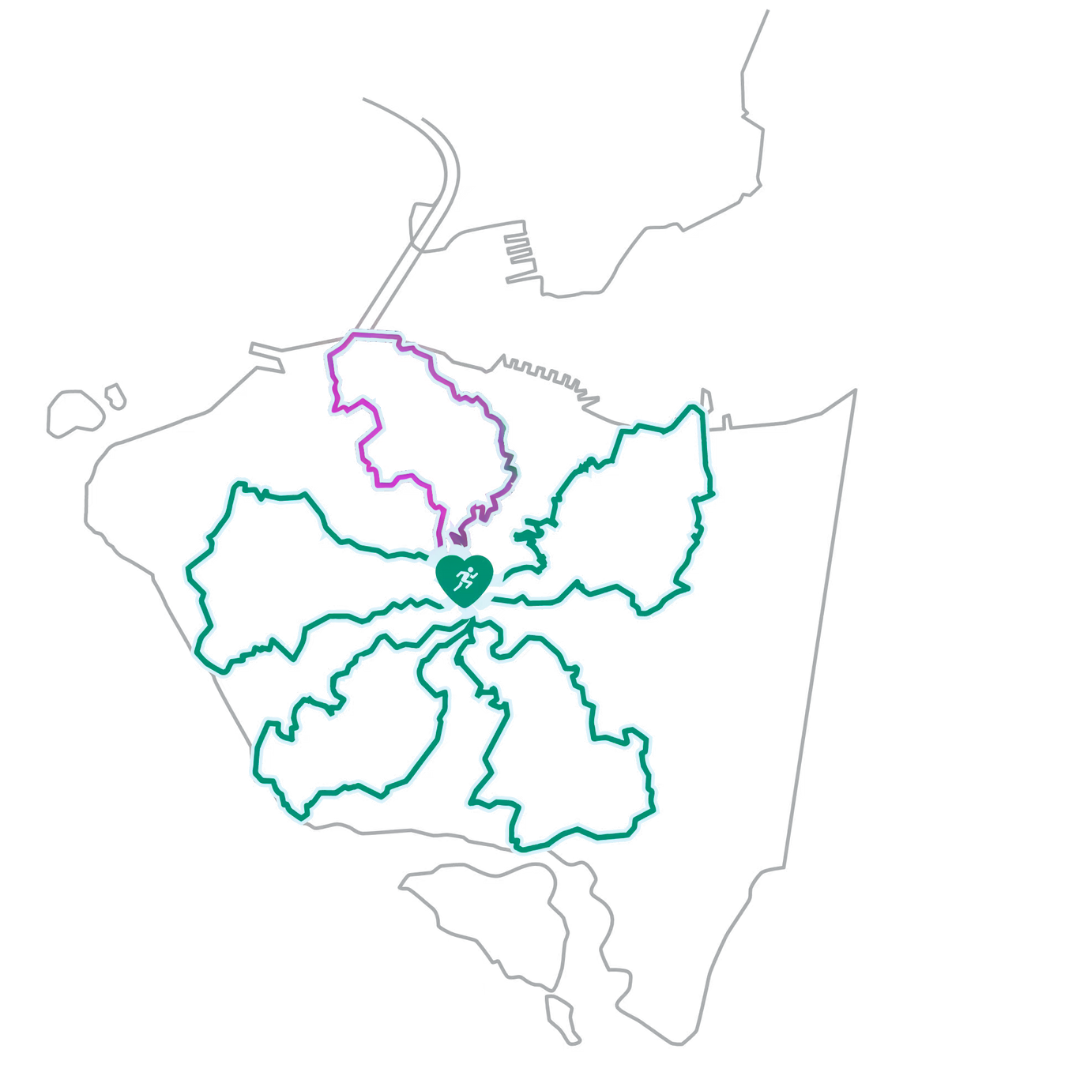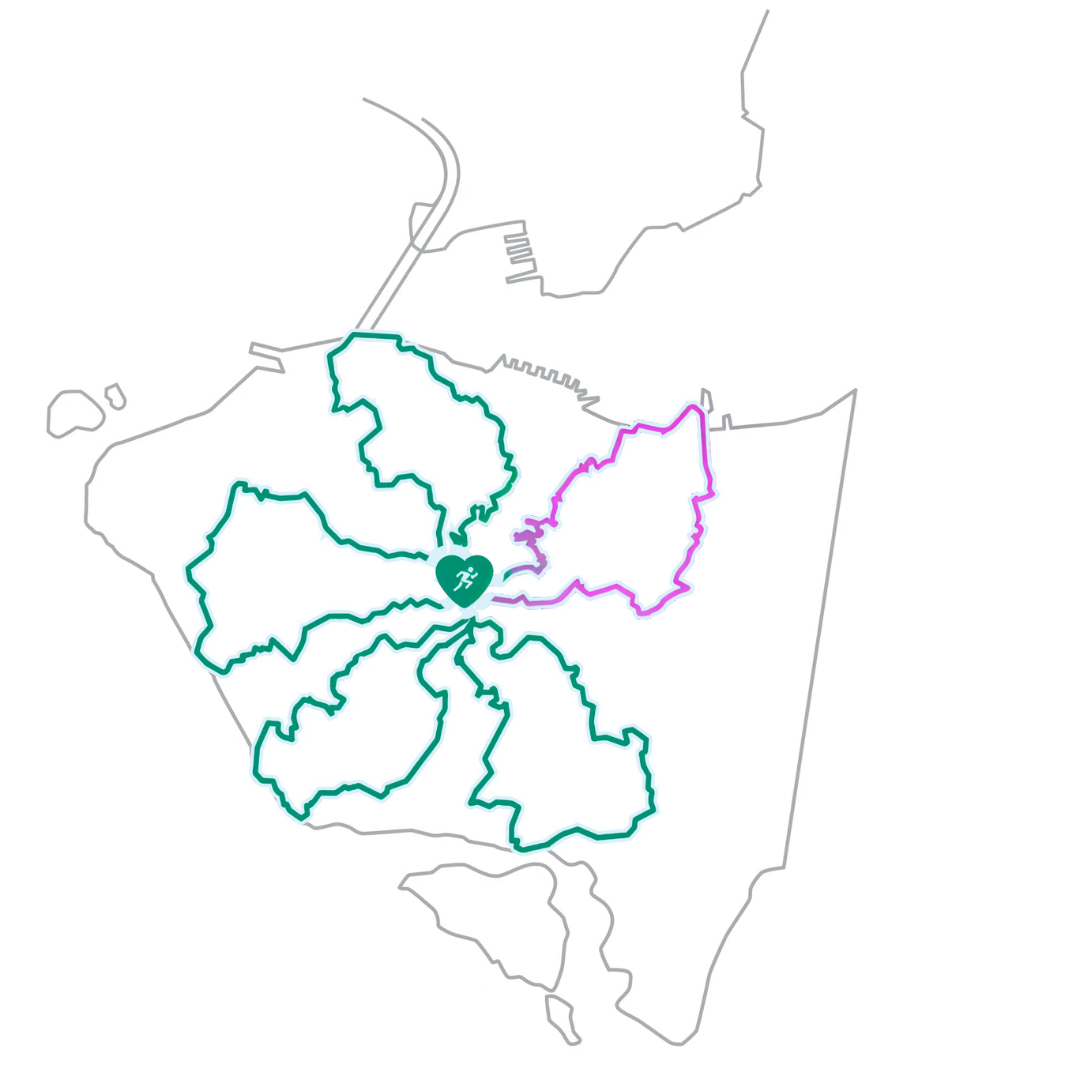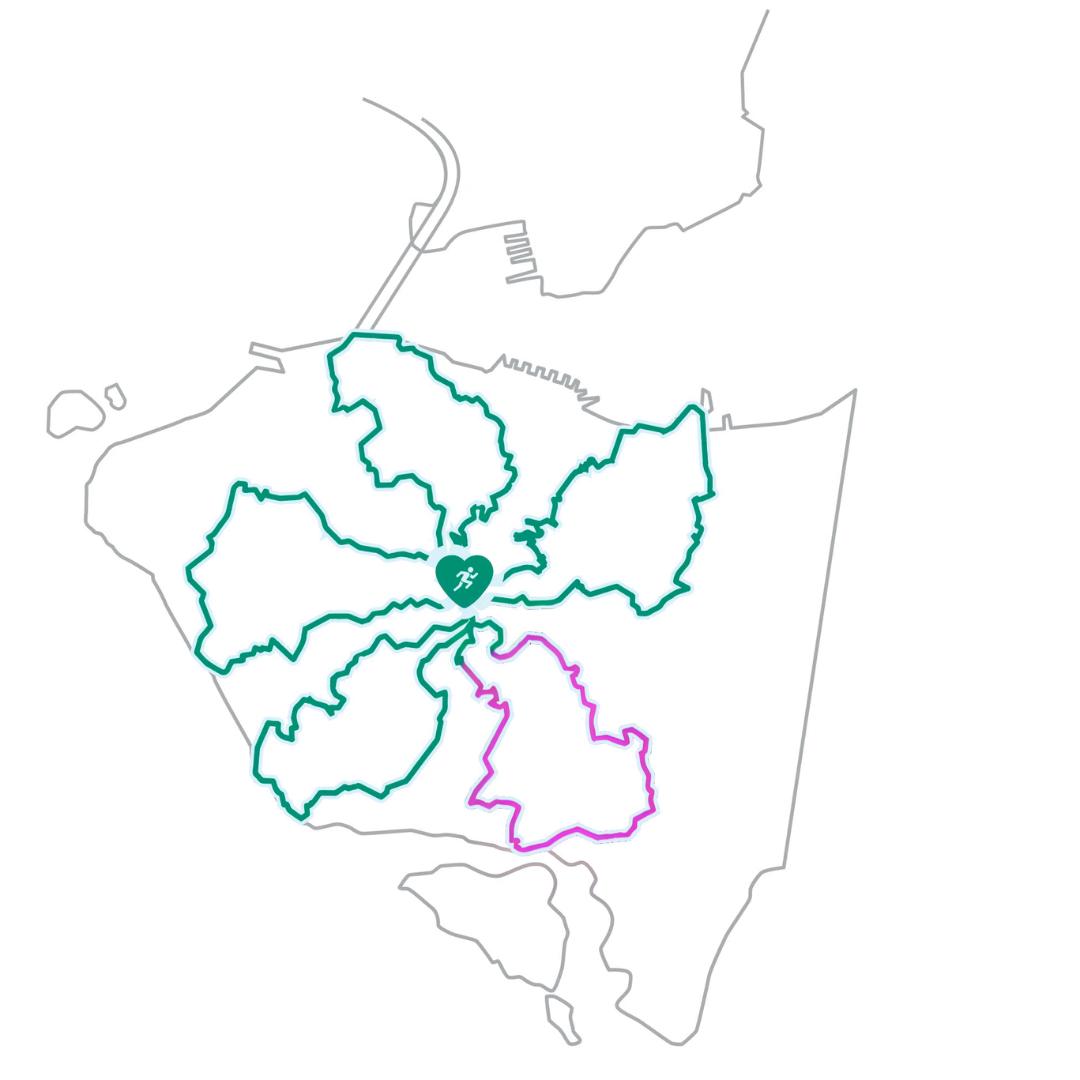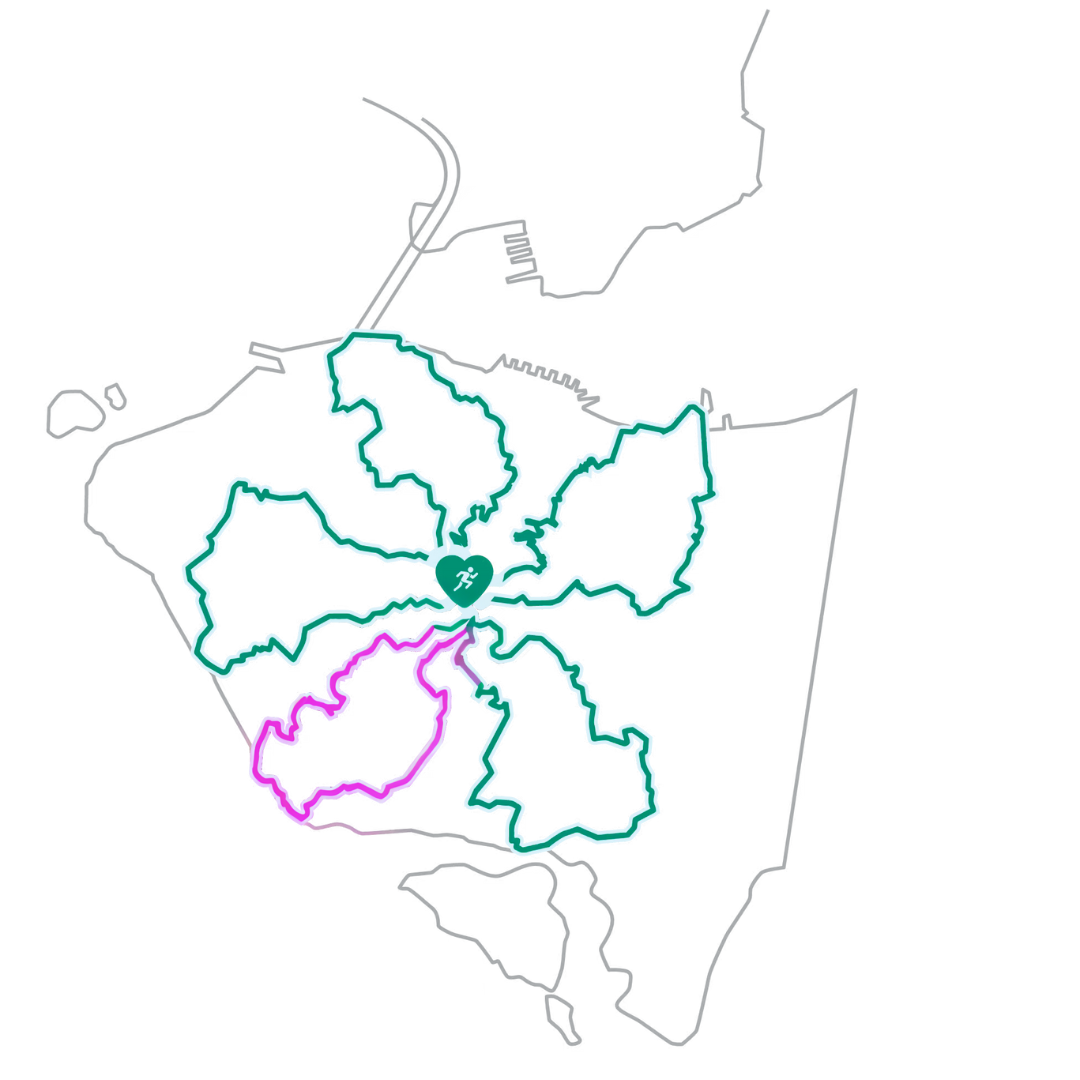I. An Enduring Emblem: Introduction to Bauhinia x blakeana
A. The Hong Kong Orchid Tree: A Unique Floral Identity
Bauhinia x blakeana Dunn, commonly known as the Hong Kong Orchid Tree, is a remarkable leguminous tree celebrated for its large, vibrant, purplish-red, orchid-like flowers and distinctive bilobed leaves.1 It holds the esteemed position of the floral emblem of Hong Kong, a symbol deeply interwoven with the city's identity, history, and visual iconography.1 The tree's narrative is particularly compelling as it is a sterile hybrid, believed to have originated from a single tree discovered in Hong Kong and subsequently propagated clonally.1 This unique genesis means its very existence and proliferation are intrinsically linked to human observation and horticultural intervention within Hong Kong, making its story inseparable from that of the city itself. Its status as an emblem, therefore, is not merely the adoption of a beautiful, naturally occurring plant, but a celebration of a unique botanical entity that Hong Kong discovered, nurtured, and propagated from a singular, serendipitous find.
B. Purpose and Scope of the Report
This report aims to provide a comprehensive, expert-level analysis of Bauhinia x blakeana. It will delve into its historical discovery and naming, detail its botanical characteristics and cultivation requirements, explore its profound symbolic significance to Hong Kong, and document its pervasive cultural and civic impact. The subsequent sections will guide the reader through the multifaceted story of this unique flower, examining how it became and remains an enduring symbol of Hong Kong.
II. Genesis of an Icon: History, Discovery, and Naming
A. The Discovery Narrative: A Serendipitous Find
The story of Bauhinia x blakeana begins around 1880 with its discovery by a French Catholic missionary of the Paris Foreign Missions (MEP).1 Several sources identify this missionary as Jean-Marie Delavay, a notable plant collector.4 The tree was found near the ruins of a house above the shoreline of western Hong Kong Island, in the vicinity of Pok Fu Lam.1 While an alternative account suggests discovery by monks in Canton (now Guangzhou) and subsequent introduction to Hong Kong 9, the Pok Fu Lam discovery by the French missionary is more widely corroborated and detailed in historical records.
Following its discovery, cuttings were taken and initially cultivated near Béthanie, a sanatorium operated by the French Mission in Pok Fu Lam.4 From there, the plant was propagated and introduced to the Hong Kong Botanical Gardens (then known as the Botanical Gardens, Victoria/Central).1 This movement from a wild, chance discovery to a cultivated specimen within colonial-era institutions marks the first step in its journey towards becoming an icon.
B. Formal Description and Naming: Honoring Patronage and Science
The first thorough scientific description of the tree was undertaken by Stephen Troyte Dunn, then Superintendent of the Botanical and Forestry Department of Hong Kong. In his paper published in the Journal of Botany (46: 325) in 1908, Dunn formally assigned the tree to the genus Bauhinia and named it Bauhinia x blakeana.1 The specific epithet "blakeana" was chosen to honor Sir Henry Blake, the British Governor of Hong Kong from 1898 to 1903, and his wife, Lady Blake.1 Sir Henry was known for his keen interest in botany and his promotion of the Hong Kong Botanic Gardens.1
The genus name Bauhinia itself was bestowed by Linnaeus to honor the 16th-century Swiss botanist brothers, Johann and Gaspard Bauhin. This choice was particularly apt, as the characteristic bilobed leaves of Bauhinia species, with their two identical lobes, can be seen to represent the twin brothers.9
C. Early Cultivation and Clonal Origin: A Single Ancestor
Dunn's 1908 description was based on trees cultivated in the Hong Kong Botanical Gardens. These, in turn, had been grown from cuttings taken from the trees at the French Mission in Pokfulam, which were themselves derived from the single tree discovered in the wild.1 There is a strong consensus among botanical sources that all Bauhinia x blakeana trees in cultivation today are clones of that original, single tree.1 This makes every Hong Kong Orchid Tree a direct genetic descendant, a living link to that specific plant found near Pok Fu Lam circa 1880.
The tree began to be widely planted throughout Hong Kong from 1914 onwards.1 Its popularity reportedly surged after a specimen in the Botanical Gardens demonstrated remarkable resilience by withstanding a devastating typhoon in 1906.5
D. The Chinese Name "洋紫荊" (yáng zǐ jīng) and Its Nuances
The common Chinese name for Bauhinia x blakeana is "洋紫荊" (yáng zǐ jīng).1 The character "洋" (yáng) translates to 'foreign' or 'ocean,' implying an overseas or non-native origin. Following the transfer of sovereignty of Hong Kong to the People's Republic of China in 1997, this "foreign" connotation was deemed inappropriate by the PRC government for a symbol of the Hong Kong Special Administrative Region.1 Consequently, the name is frequently shortened to "紫荊" (zǐ jīng) in official contexts.1 This shortening, however, introduces a degree of botanical confusion, as "紫荊" (zǐ jīng) is the established Chinese name for trees of the genus Cercis, commonly known as Redbuds.1
Milestones of the Bauhinia x blakeana
-
c. 1880
Discovered by a French missionary near Pok Fu Lam, Hong Kong Island.
-
1908
Formally named Bauhinia x blakeana by S.T. Dunn, honoring Governor Sir Henry Blake.
-
1914 onwards
Wider planting begins throughout Hong Kong, gaining popularity after surviving a typhoon in 1906.
-
1965
Adopted as the floral emblem of Hong Kong by the Urban Council.
-
1993
Appears on Hong Kong currency, replacing symbols of the British monarch.
-
1997
Features prominently on the Hong Kong Special Administrative Region (HKSAR) flag.
III. The Living Jewel: Botanical Profile and Cultivation
A. Botanical Classification: A Leguminous Hybrid
Bauhinia x blakeana belongs to the Fabaceae (Leguminosae) family, specifically within the Cercidoideae subfamily.12 The 'x' in its scientific name explicitly denotes its status as a hybrid.8
For many years, its parentage was presumed to be a cross between Bauhinia purpurea L. and Bauhinia variegata L..2 This hybrid origin has been repeatedly confirmed. More definitively, research around 2025 established *Bauhinia purpurea* as the maternal parent and *Bauhinia variegata* as the paternal (pollen-donating) strain.1
Common names include Hong Kong Orchid Tree, Blake's Bauhinia, Camel's Foot, and Purple Orchid Tree.1
Botanical Snapshot
Flower
Large (12-15cm), orchid-like, purplish-red/magenta. 5 petals, 5 fertile stamens, 1 pistil. Fragrant. Blooms Nov-Apr.
Leaf
Large (10-20cm), bilobed (like butterfly wings or camel's foot). Gray-green. "Clever Leaf" (聰明葉) in local folklore.
Hybrid Origin
B. purpurea (maternal) x B. variegata (paternal). Sterile, does not produce viable seeds. Propagated clonally.
Tree
Semi-deciduous, 3.6-6m (up to 10m) tall. Rounded, bushy canopy. Smooth gray bark, rougher with age.
B. Detailed Morphology: A Feast for the Eyes
Bauhinia x blakeana is admired for its striking ornamental features: tree structure, leaves, flowers, and its characteristic lack of fruit set due to sterility.1,2
| Feature | Bauhinia x blakeana | Bauhinia purpurea | Bauhinia variegata var. variegata |
|---|---|---|---|
| Petal Colors | Rose-purple with darker veins, whitish towards margins | Variable: pale pink to violet | Purple, streaked with red and yellow |
| No. Fertile Stamens | 5 (pink) | 3 (rarely 4) | 5 |
| Flowering Period | Longest: Sept - Apr/June (8-10 months) | Sept - Jan | Late Dec - Apr |
| Fruit Set | Extremely rare / None (sterile) | Produces pods | Produces pods |
| Source: Primarily 7; supporting details from.11 | |||
C. The Sterile Hybrid: A Biological Enigma
The sterility of Bauhinia x blakeana is a cornerstone of its botanical identity. It is confirmed as a sterile hybrid, meaning it does not produce viable seeds and therefore cannot reproduce sexually.1 Propagation must be vegetative, leading to the clonal population. This means every new tree is a direct result of human action. Its lack of genetic diversity makes it theoretically more vulnerable, but its inability to spread by seed means it is not invasive.1,2
D. Habitat and Cultivation: Nurturing the Emblem
Cultivation & Care Guide
Light
Full sun (preferred for best flowering); tolerates partial shade.
Water
Moderate; regular during growth, drought tolerant once established.
Soil Type
Adaptable (clay, loam, sand); fertile and moist preferred.
Soil Drainage
Well-drained (essential to prevent root rot).
Soil pH
Slightly acidic to neutral ( pH <7.5); avoid alkaline.
Hardiness
USDA Zones 9-11. Sensitive to frost.
Key Propagation Methods:
- Cuttings (semi-hardwood)
- Grafting (onto other Bauhinia species)
- Air-layering
- Tissue Culture (micropropagation)
Based on Table 2 from source material.2
IV. A Symbol Forged: Adoption and Meaning as Hong Kong's Emblem
A. Adoption by the Urban Council (1965): An Early Recognition
The formal recognition of Bauhinia x blakeana as a symbol of Hong Kong by the Urban Council in 1965 was an early milestone.1 The flower had already been adopted as the Urban Council's own logo prior to this.4
B. Symbolic Interpretations: A Multifaceted Emblem
The symbolism of Bauhinia x blakeana is rich:
- Hybrid Nature: Reflects Hong Kong's blend of Chinese and British influences.3
- Resilience and Unity: Symbolizes the spirit of Hong Kong's people.3,5
- Beauty and Elegance: Represents natural (cultivated) heritage.3
- Neutrality: Chosen for the HKSAR flag partly for its apolitical nature during the transition.4
- Energy and Vitality (Flag): Stylized design implies movement and dynamism.4
- "One Country, Two Systems": Linked explicitly in the HKSAR flag context.17
Deconstructing the HKSAR Flag

- Red Field: Signifies the motherland (China), festivity, nationalism, and celebration.17
- White Stylized Bauhinia Flower: A harmonizing symbol representing the "One Country, Two Systems" principle. Its five petals are arranged dynamically, like a windmill, symbolizing Hong Kong's energy and continuous progress.4,17
- Five Red Stars (on petals): Replicate those on the PRC national flag, symbolizing Hong Kong compatriots' love for their motherland and affirming Hong Kong as an inalienable part of China.5
C. Points of Discussion: The "Inauspicious" Choice?
Criticisms arose regarding its selection, focusing on:
- Sterility: Seen by some as a "barren badge," potentially inauspicious.4
- Non-Indigenous Parents: Parent species are not native to Hong Kong.2,4
- Artificially Maintained Cultivar: Depends entirely on human horticultural practices.20
Conversely, its "constructed" nature and hybridity are seen by others as perfectly reflecting Hong Kong's story of migration and successful establishment.4
| Medium/Context | Date of Introduction/Prominence | Key Symbolic Meaning(s) |
|---|---|---|
| Urban Council Emblem/Logo | 1965 (emblem) / c.1965 (logo) | Floral emblem of Hong Kong, local pride, beauty. |
| HKSAR Flag | 1997 (design process 1980s/90s) | Hybrid heritage, "One Country Two Systems," neutrality, dynamism, energy, HK as part of China (stars), harmony. |
| Hong Kong Coins | 1993 | Neutrality during transition, replacement of colonial symbols, local identity. |
| Hong Kong Banknotes | Post-1993 | Local identity, beauty. |
| "Clever Leaf" (聰明葉) Custom | Traditional/Ongoing | Wisdom, good luck in studies (local folklore). |
| Golden Bauhinia Square Statue | 1997 | Reunification, prosperity, enduring bloom. |
| General Civic/Cultural Depictions | Ongoing | Resilience, unity, elegance, Hong Kong's unique identity. |
| Source:.1 | ||
V. Woven into the City's Fabric: Bauhinia x blakeana in Hong Kong's Cultural and Civic Life
A. The Flag of Hong Kong: A Stylized Bloom
The HKSAR flag, featuring the stylized white Bauhinia on a red field, was designed by a team including Tao Ho and officially hoisted on July 1, 1997.1,4 The "Black Bauhinia" variant emerged during the 2019-2020 protests as a symbol of dissent.17

B. Currency: A Floral Standard
The Bauhinia first appeared on Hong Kong currency in 1993, replacing British monarch effigies on coins and featuring on banknotes. This was chosen for its neutrality.1,5

C. Other Official and Civic Depictions
The flower appears on Hong Kong's Regional Emblem (since 1997) and was on the Urban Council's armorial bearings (1979).1 The Golden Bauhinia Square features "The Forever Blooming Bauhinia" statue, a gift from China for the 1997 reunification.1,36 Hong Kong Airlines uses "BAUHINIA" as its callsign.1 The LCSD promotes the tree in parks.8

D. Cultural Manifestations: Art, Literature, and Beyond
The flower features in local art (e.g., Elena Roche, Ellen Pau)1 and literature. "The Bauhinia Project" uses its name for pro-democracy activism and poetry.37 Its bark, leaves, and flowers are used in Traditional Chinese Medicine.25
VI. Trail Run: Exploring Bauhinia-Lined Paths
A unique way the running community in Hong Kong engages with the Bauhinia symbol is by using their footsteps to paint Bauhinia shapes via GPX tracks. This creative endeavor combines physical activity with a tribute to the city's floral emblem.
The roadbook for creating this five-petal Bauhinia track, often starting from the Peak, is as follows:
Petal 1: Golden Bauhinia Square

Peak Galleria → Barker Road → Wan Chai Gap → Wan Chai Immigration Tower Footbridge → Golden Bauhinia Square → Tamar Park → Tramway Path → Old Peak Road → Peak Galleria.
Petal 2: Sun Yat-sen Park

Peak Galleria → Old Peak Road → Conduit Road → Robinson Road → Sun Yat-sen Memorial Park > Central and Western Promenade > Des Voeux Road West > Queen's Road West → Pok Fu Lam Road → Lung Fu Shan Fitness Trail > Harlech Road > Peak Galleria.
Petal 3: Pokfulam Reservoir

Peak Galleria → Harlech Road → Hong Kong Trail Section 1 → Pokfulam Family Trail → Pokfulam Reservoir Road → Peak Road → Peak Galleria.
Petal 4: Chi Fu Fa Yuen

Peak Galleria → Peak Road → Pok Fu Lam Reservoir Road → HK Island Trail Section 2 → Chi Fu Fa Yuen → Pok Fu Lam Road → HK Island Trail Section 2 > Peel Rise > Peak Road > Peak Galleria.
Petal 5: Aberdeen Reservoir

Peak Galleria → Peak Road → Peel Rise → Aberdeen West Catch Water → Aberdeen Nature Trail → Hong Kong Island Trail Section 4 → Wan Chai Gap Park → Peak Road → Barker Road → Peak Galleria.
Runners use GPS tracking to map these routes, visually creating the Bauhinia flower shape on their digital maps. This artistic expression of athleticism celebrates Hong Kong's unique geography and its floral emblem.
Upcoming: The FKT page of this route will be updated here once approved.
VII. Concluding Remarks: The Enduring Legacy of the Hong Kong Orchid Tree
A. Summary of Multifaceted Importance
Bauhinia x blakeana is more than an attractive tree; it's a profound symbol of Hong Kong. Its unique botanical status as a sterile hybrid, originating from a single discovery and perpetuated by human hands, mirrors the city's capacity to nurture the unique. Its journey from colonial botanical interest to its place on the HKSAR flag reflects Hong Kong's evolution.
B. The Future of the Emblem
Ongoing scientific research, like the Bauhinia Genome Project, continues to explore its genetics.1 The conservation of this unique genetic heritage is vital. As Hong Kong evolves, so may the symbolism of its floral emblem, as seen with interpretations like the "Black Bauhinia."
C. Final Reflection
Bauhinia x blakeana illustrates the interconnectedness of nature, culture, science, and political identity. It is an emblem "made in Hong Kong" – nurtured, defined, and imbued with meaning by the city and its people. It's a testament to Hong Kong's unique history, horticultural ingenuity, and complex, ever-evolving identity.
Works Cited
- 1. Bauhinia × blakeana - Wikipedia, accessed May 27, 2025, https://en.wikipedia.org/wiki/Bauhinia_×_blakeana
- 2. Hong Kong Orchid Tree (Bauhinia blakeana): All You Need To Know, accessed May 27, 2025, https://www.gardenia.net/plant/bauhinia-blakeana
- 3. A Guide to Hong Kong's Official Flower: The Bauhinia Blakeana - BLOOM & SONG, accessed May 27, 2025, https://www.bloomandsong.com/hk-flower-delivery-locations/a-guide-to-hong-kongs-official-flower-the-bauhinia-blakeana
- 4. History of Hong Kong's Bauhinia Flower Flag | Culture - Gafencu, accessed May 27, 2025, https://igafencu.com/articles/history-of-hong-kongs-bauhinia-flower-flag-culture-gafencu
- 5. Bauhinias In Bloom: Where and When to See Hong Kong's National Flower, accessed May 27, 2025, https://www.hongkonghike.com/bauhinias-in-bloom-where-and-when-to-see-hong-kongs-national-flower/
- 7. Porcupine! 28- Diversity at a glance--Bauhinia species in Hong Kong, accessed May 27, 2025, https://www.biosch.hku.hk/ecology/porcupine/por28/28-glance-bauhinia.htm
- 8. Hong Kong Orchid Tree | Flower Appreciation, accessed May 27, 2025, https://www.fa.gov.hk/en/hong-kong-orchid-tree.html
- 9. Bauhinia x blakeana at San Marcos Growers, accessed May 27, 2025, https://www.smgrowers.com/products/plants/plantdisplay.asp?plant_id=234
- 11. HKBIH - Iconic Species - Hong Kong Orchid Tree, accessed May 27, 2025, https://bih.gov.hk/en/fast-facts/iconic-species/index-id-13.html
- 12. Bauhinia X blakeana (Hong Kong Orchid Tree) - TropPlants, accessed May 27, 2025, http://www.tropplants.com/2019/02/bauhinia-x-blakeana-hong-kong-orchid.html
- 17. Flag of Hong Kong - Wikipedia, accessed May 27, 2025, https://en.wikipedia.org/wiki/Flag_of_Hong_Kong
- 20. bridging Basel + Hong Kong - PF25 cultural projects, accessed May 27, 2025, https://www.pf25.org/2023
- 25. 2277–4998 A COMPREHENSIVE REVIEW OF BAUHINIA X BLAKEANA - THE HONG KONG ORCHID TREE, accessed May 27, 2025, https://ijbpas.com/pdf/2025/May/MS_IJBPAS_2025_8940.pdf
- 36. Blissful Delights: Highlights on the Gifts Commemorating Hong Kong's Return to the Motherland, accessed May 27, 2025, https://hk.heritage.museum/en/web/hm/exhibitions/data/blissful_delights.html
- 37. Hong Kong without Us, edited by The Bauhinia Project - The Georgia Review, accessed May 27, 2025, https://www.thegeorgiareview.com/shop/georgia-review-books/hong-kong-without-us-a-peoples-poetry-edited-by-the-bauhinia-project/
- (Note: This is a selection of key sources referenced in the original content. The full list provided in the source document is more extensive.)